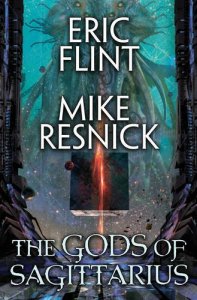Paul Di Filippo reviews Eric Flint & Mike Resnick
The Gods of Sagittarius, by Eric Flint & Mike Resnick (Baen 978-1-4767-8212-6, $25, 336pp, hardcover) May 2017
 In my recent review of Gordon Dickson’s Best of, I commented that classic one-on-one author collaborations, once a very popular mode of writing in our genre, seemed on the decline. I should have specified that a last flourishing redoubt of such popular partnerships is Baen Books. Given that they are perceived as “Old School,” this anomaly makes perfect sense. In any case, today we have two well-regarded authors with large fan bases coming together for a novel that might be the start of a long run. Let’s see how they kick things off.
In my recent review of Gordon Dickson’s Best of, I commented that classic one-on-one author collaborations, once a very popular mode of writing in our genre, seemed on the decline. I should have specified that a last flourishing redoubt of such popular partnerships is Baen Books. Given that they are perceived as “Old School,” this anomaly makes perfect sense. In any case, today we have two well-regarded authors with large fan bases coming together for a novel that might be the start of a long run. Let’s see how they kick things off.
The first thing to mention is the type of SF novel this is. I’m not sure the category even has a name, though I’ve cited its existence before now. Here is the defining quality of the sub-genre: it intelligently deploys all the standard apparatus and furniture of SF–robots, rockets, and rayguns–either in a space opera or in a more limited setting, but without being sincerely and rigorously extrapolative. At the same time, the story is not merely a “Bat Durston” tale–a western or other genre in SF drag–because the scientific/technological elements are indeed integral to the tale. It’s just that they are not “realistically” deployed or accounted-for in the manner of hardcore speculative futurism.
The Gods of Sagittarius is situated “thousands of years” in the future, when aliens abound, and interstellar travel among many human-settled worlds is taken for granted. Yet both the culture of this era and much of its gadgetry do not in any way flow from millennia of probable change and advancement and estrangement. The human somatype is unaltered; smart-aleck AIs would be familiar to Tony Stark; and academia, the media and capitalism are utterly recognizable presences. So we are not in Stross or Rajaniemi or even Kim Stanley Robinson 2140 territory.
But as I’ve also said before, this kind of SF does not perturb me or seem to me unworthy of attention. It’s a kind of stylized kabuki drama or commedia dell’arte: the forms are hardwired, and what matters is how the writer fills them differently.
So with that long preamble behind us, let me affirm that Flint and Resnick deliver an outstanding, madcap, goofball adventure, with plenty of surprises and not a dull moment. If you want some points of comparison, I would adduce Ron Goulart, Keith Laumer, James Schmitz and–a fellow who has unfortunately dropped off the publishing map–that master of surreal japes, Philip Palmer.
Our authors begin with two threads of narrative which, as such setups always do, converge into a single stream. We are first introduced to some humans: the bodyguard-for-hire Russ Talbot, and his patron of the moment, the intellectual giant (but practical klutz) Lord Rupert Shenoy. Shenoy’s latest fixation is the planet Cthulhu, a prison world where a most unsettling tragedy has taken place. Shenoy believes that the incident points towards the survival of the Old Ones, a precursor race deemed extinct. So off he and Tabor fly (along with a fellow academic named Basil). That’s the first three chapters.
The next eight chapters acquaint us intimately with a member of the alien race dubbed the Knack. And here’s where Flint and Resnick amp up the comedic weirdness. We immediately meet Occo, whose description, deliberately withheld until chapters later, is typical of the ambiance: I’m thinking Larry Niven’s Puppeteers through a kaleidoscope.
As they headed toward the passageway, an impressive-looking alien emerged from it. The creature was about six feet tall, four-legged, with its torso rising straight up from the middle of the legs. Unlike a terrestrial quadruped, from the waist-equivalent down it seemed to have no clear directional orientation—much the way a tripod or stool might be said to face in any direction. Its upper torso and head, on the other hand, had a clear front-and-back orientation. There were only two arms and two eyes.
And two mouths, which was a little creepy. One above the other. The lower mouth was for ingesting food, for which purpose Tabor knew it had an impressive set of quasi-teeth, although they weren’t currently visible. The much smaller upper mouth was only used for breathing and speaking. The alien had no nose or nostrils. Its wide-jawed equivalent of a face was dominated by two deeply-set, large, mustard-colored eyes.
Its legs and abdomen were clothed in what resembled Samurai-style armor; linked iron plates and lacquered leather, which was actually some sort of artificial—and much lighter—protective gear. The torso was covered only by a brightly-colored vest crisscrossed by several shoulder belts, one of which held some sort of weapon or tool in a holster.
Occo, a shaman conversant with technology as well, is the last of her clan, and is determined to seek out the perpetrators of the genocide. So “she” and her conjured-up “familiar,” Bresk, set out for some armaments to help. This involves a raid on The Repository, a vault of Old Ones artifacts. There, Occo comes into possession of the Warlock Variation Drive, a sentient, possibly insane teleportation unit that looks like a mauve cruciform vegetable (I’m recalling a similar dubious helper, the Prize in Sheckley’s Dimension of Miracles), and the Skerkud Teleplaser, a smart weapon the form of a soup tureen. Before you can say “Douglas Adams,” Occo & Company are also present on Cthulhu. From there, the allied humans and the Knack crew will be battling a dizzying array of exotic rivals for the treasures of the Old Ones, as well fending off as the not-quite-extinct Old Ones themselves. The book ends in a temporary jubilant victory. However, the mission of the motley band is not over, as the Warlock Variation Drive explains: “[You] took it upon yourselves to use the ancient powers…. [And] when you wake up one the rest start stirring too. The Old Ones, the Fiends, the Hoar Ghosts, the Unfriendlies, the Estrangers—even They-Who-Must-Not-Be-Named!”
A couple of final points about what is essentially a Marx Brothers romp in space. The dialogue-heavy text is well-suited to the comedic intentions, giving everyone lots of character-revelatory exposition, along the lines of snark and misunderstanding and insult. Trying to discern which parts Flint wrote and which parts Resnick wrote is futile, as the prose is well blended. And any book which can insert a gratuitous joke about Lem’s Solaris into the final chapter is one that has equal amounts of wit to accompany its Carrollian slapstick.






